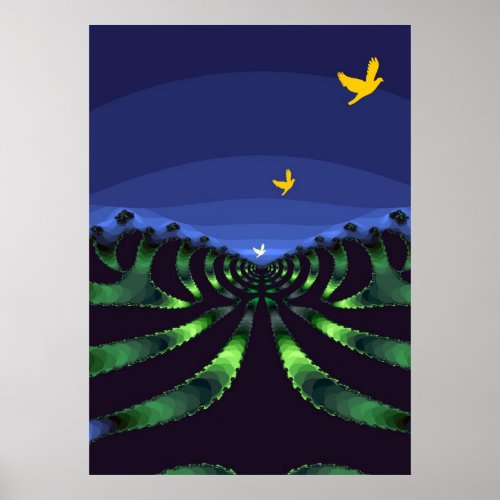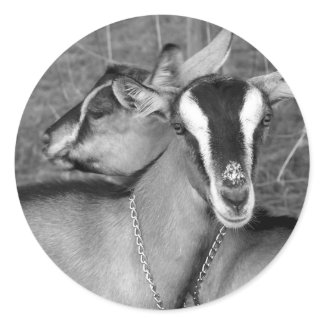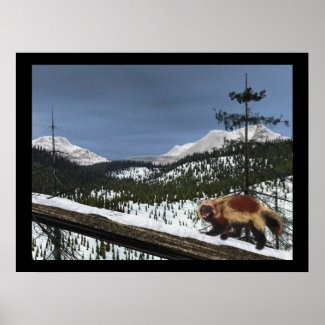This deck of Bicycle playing cards features the spectacular male Indigo Bunting perched on a branch. This tiny bird is not often seen. He is shy and tends to avoid humans. His habitat is farmland, brush areas, and open woodlands. He has incredibly brilliant iridescent blue feathers and a very sweet song. Here he is set against a lovely pastel blue sky.
A wonderful sticker with a black and white version of our popular image of two alpine/oberhasli mix young does standing together facing opposite directions. One sister looks at the camera while the other stands watch.
From the artist:
"A digital painting of a wolverine in the northern wilderness. I do not know if you have ever heard the term "roaring silence." Roaring silence is encountered only when it is extremely quiet; no cars, no airplanes, none of the typical man made sounds. You can hear the stillness and it is quite loud. It's the sound of the planet, or the universe. I am not sure what causes it. It is becoming ever harder to experience.
The wolverine is one of those species which needs large quiet spaces to survive. The wolverine resembles a small bear. The animals frequent remote boreal forests, taiga, and tundra in the northern latitudes. The wolverine, Gulo gulo (Gulo is Latin for "glutton"), also referred to as glutton, is the largest land-dwelling species of the family Mustelidae (weasels). It is a stocky and muscular carnivore, closely resembling a small bear. The species has a reputation for ferocity and strength out of proportion to its size, with the documented ability to kill prey many times its size. With short legs, broad and rounded head, and small eyes with short rounded ears, it resembles a bear more than other mustelids.Though its legs are short, its large five-toed paws and plantigrade posture facilitate movement through deep snow.
Wolverines are solitary, requiring much room to roam. Individual wolverines may travel 15 miles (24 kilometers) in a day in search of food. Because of their habitat requirements, the animals are found primarily in remote reaches of the Northern boreal forests and subarctic and alpine tundra of the Northern hemisphere, with the greatest numbers in northern Canada, the U.S. state of Alaska, the Nordic countries of Europe, and throughout western Russia and Siberia. Their populations have experienced a steady decline since the 19th century in the face of trapping, range reduction and habitat fragmentation, such that they are essentially absent in the southern end of their European range. It is, however, estimated that large populations remain in North America and northern Asia. Recently compiled genetic evidence suggests that most of North America's wolverines are descended from a single source, likely originating from Beringia (the area of the Ice Age land bridge between present day Alaska and Siberia) during the last glaciation and rapidly expanding thereafter, though there is considerable uncertainty to this conclusion due to the difficulty of collecting samples in the extremely depleted southern extent of the range.
The adult wolverine is about the size of a medium dog, with a length usually ranging from 26–42 in., a tail of 6.7–10 in., and a weight of 20–55 lbs, though exceptionally large males can weigh up to 71 lbs The males are as much as 30% larger than the females and can be twice the female's weight. Shoulder height is reported from 12 to 18 in. It is the largest of terrestrial mustelids; only the marine-dwelling sea otter and giant otter of the Amazon basin are larger. Wolverines have thick, dark, oily, fur which is highly hydrophobic, making it resistant to frost. This has led to its traditional popularity among hunters and trappers as a lining in jackets and parkas in Arctic conditions. A light silvery facial mask is distinct in some individuals, and a pale buff stripe runs laterally from the shoulders along the side and crossing the rump just above a 9.8–14 in. bushy tail. Some individuals display prominent white hair patches on the throat or chest. Like many other mustelids, it has potent anal scent glands used for marking territory and signaling. The pungent odor has given rise to the nicknames "skunk bear" and "nasty cat."
Wolverines, like other mustelids, possess a special upper molar in the back of the mouth that is rotated 90 degrees, towards the inside of the mouth. This special characteristic allows wolverines to tear off meat from prey or carrion that has been frozen solid. Wolverines eat a bit of vegetarian fare, like plants and berries, in the summer season, but this does not make up a major part of their diet. —they are tenacious predators with a taste for meat. Prey mainly consists of small to large-sized mammals and the wolverine has been recorded killing prey such as adult deer that are many times larger than itself. Prey species include porcupine, squirrel, beaver, marmot, rabbit, vole, mice, shrew, lemming, caribou, roe deer, white-tailed deer, mule deer, sheep, moose, and elk. Smaller predators are occasionally preyed on, including martens, mink, foxes, canada lynx, weasels, Eurasian lynx, and coyote and wolf pups. Wolverines often pursue live prey that is relatively easy to obtain, including animals caught in traps, newborn mammals and deer (including adult moose and elk) when they're weakened by winter or immobilized by heavy snow. The diet is sometimes supplemented by bird's eggs, birds (especially geese), roots, seeds, insect larvae and berries. A majority of the wolverine's sustenance is derived from carrion, which they depend on almost exclusively in winter and early spring. Wolverines may find carrion themselves, feed on it after the predator is done feeding (especially wolf packs) or simply take it from another predator. Whether eating live prey or carrion, the wolverine's feeding style appears voracious, leading to the nickname of "glutton" (also the basis of the scientific name). However, this feeding style is believed to be an adaptation to food that is scarcely encountered, especially in the winter.[14]Wolverines easily dispatch smaller prey, such as rabbits and rodents, but may even attack animals many times their size, such as caribou, if the prey appears to be weak or injured. These opportunistic eaters also feed on carrion—the corpses of larger mammals, such as elk, deer, and caribou. Such finds sustain them in winter when other prey may be thinner on the ground, though they have also been known to dig into burrows and eat hibernating mammals.
Males scent-mark their territories, but they share them with several females and are believed to be polygamous. Females den in the snow or under similar cover to give birth to two or three young each late winter or early spring. Kits sometimes live with their mother until they reach their own reproductive age—about two years old. Wolverines inhabiting the Old World (specifically, Fennoscandia) are more active hunters than their North American cousins. This may be because competing predator populations in Eurasia are not as dense, making it more practical for the wolverine to hunt for itself than to wait for another animal to make a kill and then try to snatch it. They often feed on carrion left by wolves, so changes in the population of wolves may affect the population of wolverines.
The world's total wolverine population is unknown. The animal exhibits a low population density and requires a very large home range. The range of a male wolverine can be more than 240 sq mi., encompassing the ranges of several females which have smaller home ranges of roughly 50–100 sq mi. Radio tracking suggests an animal can range hundreds of miles in a few months. Female wolverines burrow into snow in February to create a den, which is used until weaning in mid-May. Areas inhabited non-seasonally by wolverines are thus restricted to zones with late-spring snowmelts. This fact has led to concern that global warming will shrink the ranges of wolverine populations.
The PBS series Nature released a documentary, "Wolverine: Chasing the Phantom" as episode #166 on 14 November 2010. This 53 minute documentary focuses on the efforts of a number of naturalists in the United States to track wolverines, collect genetic data, and learn more about wolverine populations, individual behavior and social behavior. It also tracks the raising of two male wolverines in captivity at an Alaska nature reserve from birth to maturity, and profiles the naturalists making these efforts."

Out of the Void Poster by Bebops
I hope to display a variety of animal images on this blog to delight us all. I have created many products featuring wildlife and pets for my Zazzle stores, Bebop's Place and Bebop's Weddings, using my original photographs and designs. I am also constantly amazed at the gorgeous animal products available from the rest of the Zazzle community. I am hoping others will enjoy this blog and even be moved to purchase some of these lovely items for gifts or just for the pleasure of having such beauty around.


